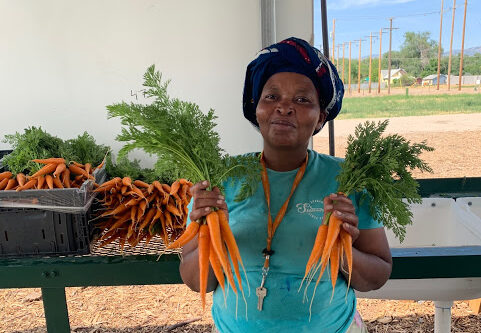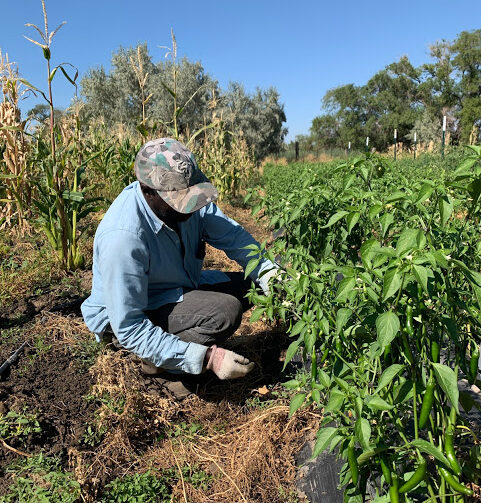These Refugees Are Planting New Roots in Salt Lake City
This farm is providing the city’s immigrant population with flavors from home.
These Refugees Are Planting New Roots in Salt Lake City
This farm is providing the city’s immigrant population with flavors from home.

That diverse selection of produce is part of what draws crowds to the Sunnyvale Farmers Market.courtesy of New Roots.
Every Saturday from June through October, New Roots sets up a table at the Sunnyvale Farmers Market in Salt Lake City. Overflowing with leafy greens, chili peppers, squash and other organically grown produce, the table features a bounty grown by farmers whose roots go far deeper than the ground they stand on at the farmers market, with ties linking them back to their homelands of Chad, Nepal, Rwanda, Somalia and Bhutan. While their backgrounds may be diverse, these farmers are all members of Salt Lake City’s burgeoning refugee community.
This group of farmers met through New Roots, an agricultural program based in Utah’s capital city that provides economic independence for refugees through leased farm plots, farmers markets and community gardens. The program is part of the International Rescue Committee (IRC), a global humanitarian relief organization founded in 1933 with locations in 25 cities nationwide. In nearly a century, the IRC has provided relief for communities on a global scale by offering opportunities for refugees living in a foreign land. New Roots estimates that 84 percent of its growers have a background in agriculture.
One of these refugees is Albert Betoudji, who emigrated to the United States with his wife and children from Chad due to a coup d’etat in 2008 between the country and Sudan. He has been farming with New Roots since 2009. Now, more than a decade later, Betoudji is a grandfather of four and one of New Roots’ longest serving farmers. He’s responsible for nearly a dozen beds at the organization’s approximately two-acre farm on Redwood Road, located about seven miles southwest of downtown. It’s one of two farms operated by New Roots. (The second is a 13-acre site in Draper, 17 miles south.) Even though it’s still early in the season, green shoots have started sprouting from the soil, mainly garlic and onions. He’s already preparing to plant mustard greens and okra—two staples he grew up eating in Chad. While he shares some of the produce with his family, who make it into stews and sauces, most of it winds up at the Sunnyvale Farmers Market where he receives a portion of the profits.
Betoudji, who helped his father on the farm as a youth during school breaks, says that one of the biggest challenges he faced when settling in Utah was adjusting to farming in a much cooler climate compared to the heat and humidity he was used to in Chad.
“I tried planting some of the crops I grew back home, like sugarcane, but because of the weather, they wouldn’t grow,” he says. “Every year I change my crops, so if something doesn’t do well, I can try something else.”
That continuously evolving selection of produce is part of what draws crowds to the Sunnyvale Farmers Market. Before the market’s arrival several years ago, the area was part of a food desert. But now on Saturdays, the market is teeming with everyone from immigrants and refugees to native Utahns, who browse the tables in search of affordable produce that proves difficult to find in this region.

James Hunter, a food entrepreneurship program officer for New Roots, says that the market is where locals turn when they’ve exhausted other resources and can’t find what they want at specialty grocers. It’s very likely they’ll find what they’re looking for at the market, which offers approximately 120 different varieties of produce. The market’s variety all comes down to the seeds and how farmers have adapted to growing them in northern Utah, an area known for its snowy winters and arid climate.
Hunter says New Roots works hard through seed distributors to source different seeds for its farmers. And many farmers will save seeds year after year, as well as import them back from their homelands. “Through the farmers, I learned that there are dozens of different varieties of eggplant grown around the globe,” he says. “We have one farmer who grows a very specific type that is orange in color that’s popular with the local Burundian community, so he’s found a niche market.”
Bali Dhakal is another farmer who accommodates his crop to market demands. Dhakal came to Utah from Bhutan with his wife and children in 2009 after a major earthquake decimated his community. He uses his background as a farmer to grow carrots, garlic, potatoes, long beans, onions, cherry tomatoes and okra. Although he does bring some of the produce home to feed his family, he says the most important thing is that none of what he grows goes to waste.
“Sometimes when you grow produce in your home garden, it gets wasted because there’s too much,” Dhakal says through a translator. “With New Roots and the farmers market, I know that everything I grow goes to people who can use it.”
Another benefit is the community that New Roots provides. It’s something especially important for refugees who arrive in Utah and know no one. Through workshops and potlucks, the farmers have built a community that helps them feel more at home living in their adopted home. And that community extends far beyond the farm’s plowed fields.
“One time at the farmers market, I met a lady who was so happy to see vegetables she used to eat [in Africa],” Betoudji says. “She said to me, ‘I couldn’t find the foods I wanted to eat in the United States, but because of your vegetables, now I am home.’”
Follow us

This work is licensed under a Creative Commons Attribution-NoDerivatives 4.0 International License.
Want to republish a Modern Farmer story?
We are happy for Modern Farmer stories to be shared, and encourage you to republish our articles for your audience. When doing so, we ask that you follow these guidelines:
Please credit us and our writers
For the author byline, please use “Author Name, Modern Farmer.” At the top of our stories, if on the web, please include this text and link: “This story was originally published by Modern Farmer.”
Please make sure to include a link back to either our home page or the article URL.
At the bottom of the story, please include the following text:
“Modern Farmer is a nonprofit initiative dedicated to raising awareness and catalyzing action at the intersection of food, agriculture, and society. Read more at <link>Modern Farmer</link>.”
Use our widget
We’d like to be able to track our stories, so we ask that if you republish our content, you do so using our widget (located on the left hand side of the article). The HTML code has a built-in tracker that tells us the data and domain where the story was published, as well as view counts.
Check the image requirements
It’s your responsibility to confirm you're licensed to republish images in our articles. Some images, such as those from commercial providers, don't allow their images to be republished without permission or payment. Copyright terms are generally listed in the image caption and attribution. You are welcome to omit our images or substitute with your own. Charts and interactive graphics follow the same rules.
Don’t change too much. Or, ask us first.
Articles must be republished in their entirety. It’s okay to change references to time (“today” to “yesterday”) or location (“Iowa City, IA” to “here”). But please keep everything else the same.
If you feel strongly that a more material edit needs to be made, get in touch with us at [email protected]. We’re happy to discuss it with the original author, but we must have prior approval for changes before publication.
Special cases
Extracts. You may run the first few lines or paragraphs of the article and then say: “Read the full article at Modern Farmer” with a link back to the original article.
Quotes. You may quote authors provided you include a link back to the article URL.
Translations. These require writer approval. To inquire about translation of a Modern Farmer article, contact us at [email protected]
Signed consent / copyright release forms. These are not required, provided you are following these guidelines.
Print. Articles can be republished in print under these same rules, with the exception that you do not need to include the links.
Tag us
When sharing the story on social media, please tag us using the following: - Twitter (@ModFarm) - Facebook (@ModernFarmerMedia) - Instagram (@modfarm)
Use our content respectfully
Modern Farmer is a nonprofit and as such we share our content for free and in good faith in order to reach new audiences. Respectfully,
No selling ads against our stories. It’s okay to put our stories on pages with ads.
Don’t republish our material wholesale, or automatically; you need to select stories to be republished individually.
You have no rights to sell, license, syndicate, or otherwise represent yourself as the authorized owner of our material to any third parties. This means that you cannot actively publish or submit our work for syndication to third party platforms or apps like Apple News or Google News. We understand that publishers cannot fully control when certain third parties automatically summarize or crawl content from publishers’ own sites.
Keep in touch
We want to hear from you if you love Modern Farmer content, have a collaboration idea, or anything else to share. As a nonprofit outlet, we work in service of our community and are always open to comments, feedback, and ideas. Contact us at [email protected].by Jennifer Nalewicki, Modern Farmer
June 5, 2021
Modern Farmer Weekly
Solutions Hub
Innovations, ideas and inspiration. Actionable solutions for a resilient food system.
ExploreExplore other topics
Share With Us
We want to hear from Modern Farmer readers who have thoughtful commentary, actionable solutions, or helpful ideas to share.
SubmitNecessary cookies are absolutely essential for the website to function properly. This category only includes cookies that ensures basic functionalities and security features of the website. These cookies do not store any personal information.
Any cookies that may not be particularly necessary for the website to function and are used specifically to collect user personal data via analytics, ads, other embedded contents are termed as non-necessary cookies.